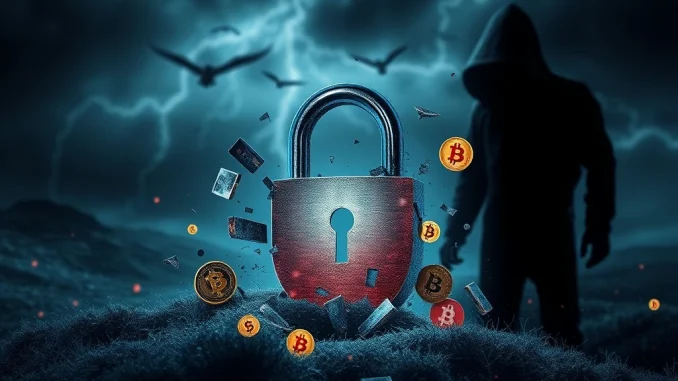
The cryptocurrency world has been rocked by an alarming revelation: crypto hacks in the first half of 2025 have already surpassed the total losses recorded throughout all of 2024. This isn’t just a slight increase; it’s a monumental surge that highlights a growing and dangerous trend in the digital asset space. If you’re holding crypto, understanding the scale of this threat is crucial.
The Unprecedented Surge in Stolen Crypto
According to data from blockchain intelligence firm Chainalysis, a staggering $2.17 billion was stolen from crypto services and personal wallets by June 2025. This figure eclipses the entirety of 2024’s losses, painting a grim picture for digital asset security. What’s driving this dramatic increase? While numerous smaller incidents contribute, a single, record-breaking event stands out as a major contributor.
Let’s break down the scale of the problem:
- Total Stolen H1 2025: $2.17 billion
- Compared to Total 2024: H1 2025 losses have already exceeded 2024’s full-year total.
- Primary Driver: A massive single attack contributing over half of the total.
The Bybit Hack: A Devastating Blow
A significant portion of the stolen crypto in the first half of 2025 can be attributed to the devastating $1.5 billion attack on Bybit in February. This incident alone accounts for nearly 70% of the total funds lost this year, making it one of the largest cryptocurrency heists in history. The sheer scale of the Bybit hack sends a chilling message about the vulnerabilities that still exist within even major crypto platforms.
While the exact method of the Bybit hack hasn’t been fully disclosed, such large-scale breaches often involve a combination of sophisticated cyber-attack techniques, including:
- Exploitation of smart contract vulnerabilities.
- Advanced phishing or social engineering to gain access to internal systems.
- Compromise of private keys or exchange hot wallets.
Who is the Lazarus Group and Why Are They Targeting Crypto?
Allegations point towards North Korea’s notorious Lazarus Group as the perpetrator behind the Bybit hack. This state-sponsored hacking collective has a long history of targeting financial institutions and cryptocurrency exchanges globally. Their motivation is clear: to generate illicit revenue for the North Korean regime, often to fund its weapons programs, bypassing international sanctions.
The Lazarus Group employs highly sophisticated tactics, including:
- Spear Phishing: Targeting specific employees with malicious emails to gain network access.
- Supply Chain Attacks: Compromising software or services used by their targets.
- Malware Deployment: Using custom-built malware to exfiltrate data or funds.
Their persistent and well-funded operations pose a significant threat to the entire crypto ecosystem, making them a prime focus for global cybersecurity efforts.
Understanding Blockchain Security Vulnerabilities
The continuous wave of crypto hacks underscores critical vulnerabilities in the ecosystem. It’s not just about sophisticated state-sponsored groups; many attacks exploit fundamental weaknesses. Enhancing blockchain security is a collective responsibility, from developers to individual users. Common attack vectors include:
- Smart Contract Exploits: Flaws in the code of decentralized applications (dApps) can be exploited to drain funds. These are often complex and require specialized auditing.
- Phishing and Social Engineering: Tricking users into revealing private keys or signing malicious transactions remains a pervasive threat. Human error is often the weakest link.
- Private Key Compromise: If private keys are stored insecurely (e.g., on a hot wallet connected to the internet), they can be stolen by malware or direct attacks.
- Centralized Exchange Vulnerabilities: Exchanges, by holding large amounts of user funds, are attractive targets. Their security infrastructure must be robust, covering everything from internal systems to withdrawal processes.
Protecting Your Digital Assets: Actionable Steps Against Crypto Hacks
Given the alarming rise in stolen crypto, what can you do to protect your investments? While no system is foolproof, adopting robust security practices can significantly reduce your risk. Think of it as building multiple layers of defense around your digital assets.
Here are essential steps for every crypto holder:
- Enable Two-Factor Authentication (2FA): Always use 2FA on exchanges and wallets. Hardware-based 2FA (like YubiKey) is superior to SMS or app-based methods.
- Use Hardware Wallets: For long-term storage of significant amounts of crypto, a hardware wallet (e.g., Ledger, Trezor) is indispensable. It keeps your private keys offline, making them virtually immune to online hacks.
- Be Wary of Phishing Attempts: Always double-check URLs, email addresses, and sender identities. Never click suspicious links or download attachments from unknown sources.
- Strong, Unique Passwords: Use complex, unique passwords for all crypto-related accounts and consider a password manager.
- Verify Smart Contracts: If interacting with dApps, ensure the smart contracts have been audited by reputable firms. Understand the risks involved with new or unaudited protocols.
- Regularly Review Permissions: If you connect your wallet to dApps, regularly review and revoke unnecessary token approvals or permissions.
- Stay Informed: Keep up-to-date with the latest security threats and best practices in the crypto space. Follow reputable security researchers and news outlets.
- Diversify Storage: Don’t keep all your funds on one exchange or in one wallet. Spread your risk.
The Broader Impact of Stolen Funds
The continuous stream of successful crypto hacks has far-reaching consequences beyond the immediate financial losses. It erodes trust in the nascent crypto industry, potentially slowing mainstream adoption. Regulators worldwide are also taking note, increasing scrutiny and pushing for stricter compliance and security standards. This could lead to more centralized control or more stringent KYC/AML requirements, which might contradict the decentralized ethos of crypto.
Moreover, these incidents can trigger market volatility, as fear and uncertainty spread among investors. The reputational damage to affected platforms can be immense, impacting their user base and future growth prospects. For the victims, the emotional and financial toll can be devastating, often with little recourse for recovery.
Industry’s Response to Enhanced Security
The industry is not standing still. The increasing frequency and sophistication of crypto hacks are pushing exchanges, dApp developers, and blockchain protocols to prioritize blockchain security like never before. This includes:
- More Rigorous Audits: Projects are increasingly undergoing comprehensive security audits by third-party firms before deployment.
- Bug Bounty Programs: Many projects offer rewards to white-hat hackers who discover and report vulnerabilities, incentivizing ethical security research.
- Decentralized Security Solutions: Innovative projects are emerging that aim to provide decentralized insurance, security monitoring, and incident response.
- Enhanced KYC/AML: While sometimes controversial, stricter identity verification processes can help prevent illicit activities and aid in tracing stolen funds.
- Collaboration with Law Enforcement: Crypto intelligence firms and exchanges are working more closely with global law enforcement agencies to track and recover stolen assets, as well as identify and prosecute perpetrators like the Lazarus Group.
Conclusion
The first half of 2025 has delivered a stark reminder of the persistent and evolving threat of crypto hacks. The staggering $2.17 billion in stolen crypto, largely driven by the Bybit hack allegedly orchestrated by the Lazarus Group, underscores the urgent need for enhanced blockchain security. While the industry is making strides, individual vigilance remains paramount. By adopting robust security practices and staying informed, crypto users can significantly bolster their defenses against these relentless digital adversaries. The future of decentralized finance depends on our collective ability to secure it.
Frequently Asked Questions (FAQs)
1. Why are crypto hacks increasing so rapidly?
The increase in crypto hacks is due to several factors: the rising value of cryptocurrencies making them attractive targets, the increasing complexity of the DeFi ecosystem introducing new vulnerabilities, and the sophistication of cybercriminal groups like the Lazarus Group. Many users also lack basic security practices, making them easy targets.
2. What was the largest crypto hack in H1 2025?
The largest crypto hack in the first half of 2025 was the alleged $1.5 billion attack on Bybit in February, which significantly contributed to the overall stolen amount.
3. How can I protect my crypto assets from being stolen?
To protect your crypto, use a hardware wallet for cold storage, enable strong 2FA on all accounts, use unique and complex passwords, be vigilant against phishing attempts, and only interact with reputable and audited decentralized applications (dApps).
4. Is the Lazarus Group the only major threat to crypto security?
While the Lazarus Group is a significant and well-known threat, they are not the only one. Numerous other state-sponsored groups, organized cybercrime syndicates, and individual hackers continuously target the crypto space. However, the Lazarus Group is particularly notable for its scale and state backing.
5. What happens if my crypto is stolen from an exchange?
If your crypto is stolen from an exchange, recovery is often difficult. Some exchanges may have insurance policies that cover certain types of losses, but this is not guaranteed. It’s crucial to report the incident to the exchange immediately and, if applicable, to law enforcement. However, prevention through personal security measures is always the best strategy.



